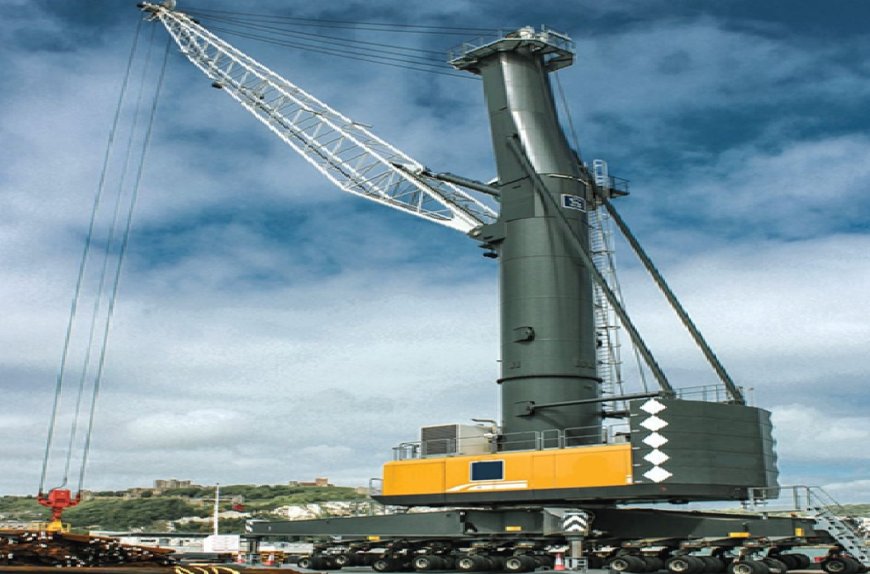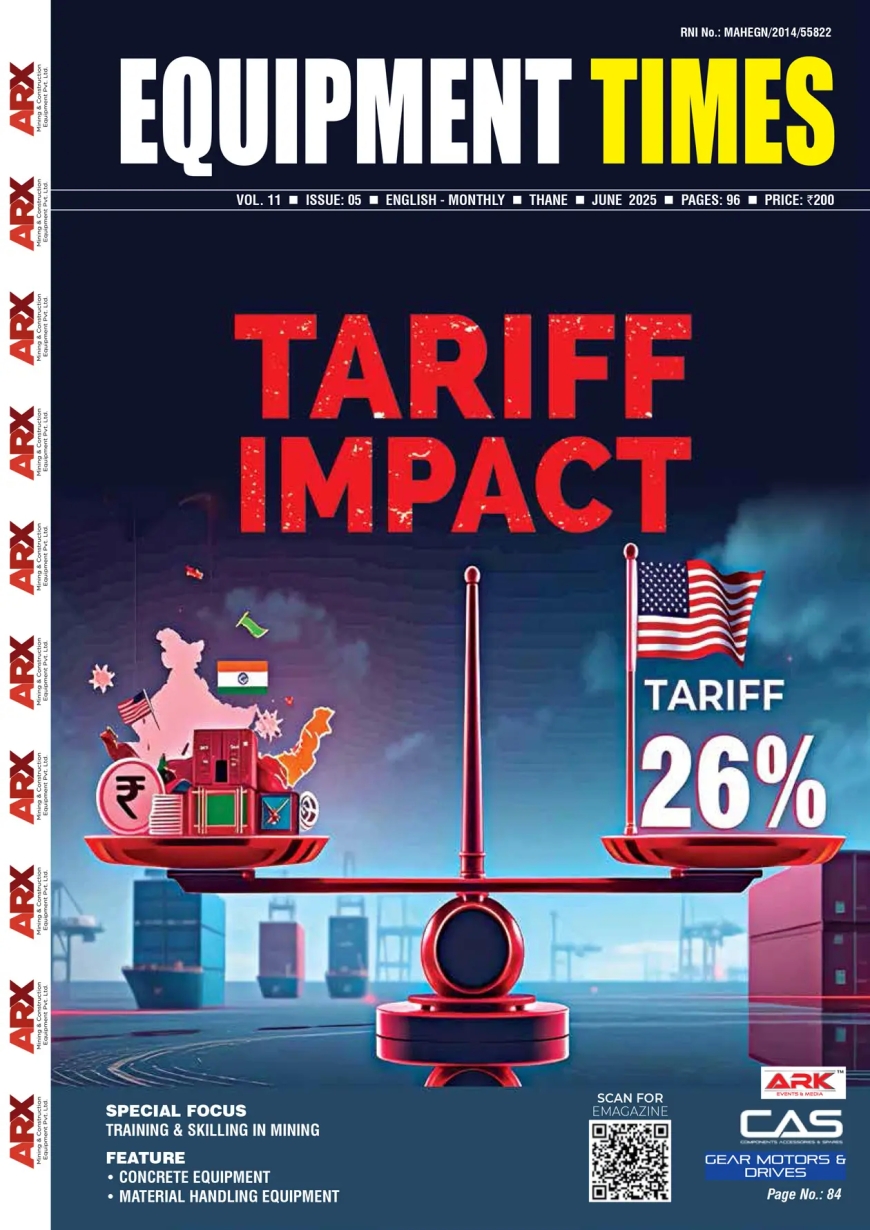RISING ABOVE The Innovative World of SLEW CRANES

In the ever-evolving landscape of construction and industrial operations, efficiency and precision are paramount. Enter the slew crane, a marvel of engineering that has revolutionized how heavy lifting tasks are accomplished. With its ability to rotate 360 degrees, the slew crane has become an indispensable tool across various sectors, from towering skyscrapers to sprawling manufacturing plants. Equipment Times delves deeper into the world of slew cranes and explore how they are shaping the future of construction and industry.
The origins of slew cranes can be traced back to ancient civilizations, where rudimentary forms of cranes were used for lifting heavy objects. However, it was not until the industrial revolution that cranes began to take on more sophisticated forms. The advent of steel manufacturing and hydraulic systems paved the way for the development of modern slew cranes, capable of handling increasingly heavier loads with greater precision.
Key Features and Functionality:
At the heart of the slew crane’s functionality lies its ability to rotate horizontally, thanks to a slew bearing or slewing ring. This pivotal feature allows operators to maneuver loads with unparalleled flexibility, reaching areas that would otherwise be inaccessible. Furthermore, slew cranes are equipped with a range of attachments and accessories, including jibs, hooks, and grabs, further enhancing their versatility in various applications.
Market:
Several factors contribute to the demand for slew cranes in India…
Infrastructure Development: India has been investing significantly in infrastructure projects such as roads, bridges, airports, ports, and railways. Slew cranes are essential equipment for lifting heavy materials and components during construction activities.
Industrial Growth: The growth of manufacturing industries, including steel, cement, automotive, and petrochemicals, requires efficient material handling solutions like slew cranes for production processes and logistics.
Urbanization: Rapid urbanization in India is driving the demand for commercial and residential construction projects, where slew cranes are commonly used for lifting and placing building materials.
Government Initiatives: Government initiatives such as “Make in India” and various infrastructure development schemes provide further impetus to the construction and manufacturing sectors, indirectly boosting the demand for slew cranes.
Port and Shipping Sector: With India’s focus on enhancing its port infrastructure and maritime trade, slew cranes play a crucial role in cargo handling operations at ports.
Technological Advancements: The introduction of advanced features and technologies in slew cranes, such as remote monitoring, automation, and safety enhancements, also contributes to market growth by improving efficiency and safety in lifting operations.
Overall, the market for slew cranes in India is expected to continue growing in the coming years, driven by infrastructure development, industrial expansion, urbanization trends, government initiatives, and technological advancements. However, specific market dynamics, competition, regulations, and economic conditions should be considered for a comprehensive understanding of the market’s nuances.
Applications Across Industries
From construction sites to shipping yards, slew cranes have found widespread adoption across diverse industries. In the construction sector, these cranes play a vital role in erecting skyscrapers, lifting heavy materials to towering heights with precision and efficiency. Similarly, in manufacturing facilities, slew cranes facilitate the movement of large components, streamlining production processes and minimizing downtime.
Technological Advancements
Technological advancements in slew cranes primarily focus on improving efficiency, safety, and automation. Some key advancements include:
Automation and Remote Control: Modern slew cranes are increasingly equipped with automation features, allowing operators to control them remotely. This not only enhances safety by reducing the need for operators to be in close proximity to potentially hazardous loads but also increases efficiency by enabling operators to control multiple cranes simultaneously.
Load Monitoring Systems: Advanced load monitoring systems are integrated into slew cranes to provide real-time feedback on load weights and distribution. This helps prevent overloading, enhances safety, and protects equipment from damage.
Telemetry and IoT Integration: Slew cranes are increasingly connected to the Internet of Things (IoT) networks, allowing for remote monitoring of crane performance, condition, and maintenance needs. Telemetry systems collect data on factors such as crane usage, stress levels, and environmental conditions, enabling predictive maintenance and optimizing operational efficiency.
Collision Avoidance Systems: To prevent accidents and improve safety, slew cranes are equipped with collision avoidance systems that utilize sensors, cameras, and advanced algorithms to detect obstacles and automatically adjust crane movements to avoid collisions.
Energy Efficiency: Advancements in motor technology and power management systems have made slew cranes more energy-efficient. Regenerative braking systems, for example, capture and store energy generated during braking for later use, reducing overall energy consumption and operating costs.
Improved Materials & Construction: Innovations in materials science and engineering have led to the development of stronger, lighter materials for slew crane components, such as booms and jibs. This results in cranes with higher lifting capacities and greater reach while maintaining structural integrity.
Enhanced Control Systems: Modern slew cranes feature advanced control systems with user-friendly interfaces and customizable settings. These systems offer precise control over crane movements, allowing operators to perform complex lifting tasks with ease.
Integration with Digital Twin Technology: Digital twin technology creates virtual replicas of physical assets, including slew cranes. By integrating with digital twin platforms, operators can simulate crane operations, conduct training exercises, and optimize performance without the need for physical prototypes.
These technological advancements continue to drive innovation in the design and operation of slew cranes, making them safer, more efficient, and more reliable tools for lifting and material handling in various industries.
Safety and Efficiency
Safety is of paramount importance in any industrial setting, and slew cranes are designed with this principle in mind. Advanced safety features such as overload protection systems, anti-collision sensors, and emergency stop mechanisms ensure that operations are conducted with the highest level of precaution. Moreover, the efficiency gains offered by slew cranes translate into cost savings for businesses, as tasks can be completed in less time and with fewer resources.
Environmental Considerations
In an era increasingly focused on sustainability, slew cranes are also making strides in reducing their environmental footprint. Manufacturers are incorporating energy-efficient components and exploring alternative power sources such as electric and hybrid systems. Additionally, the longevity of slew cranes minimizes the need for frequent replacements, further contributing to resource conservation.
Future Prospects
As technology continues to advance, the future of slew cranes looks promising. Innovations such as remote operation capabilities, autonomous functionality, and integration with digital platforms are poised to further enhance their efficiency and productivity. Moreover, as infrastructure projects become more ambitious and complex, the demand for slew cranes is expected to soar, driving further innovation in the industry. In the dynamic realm of construction and industry, slew cranes stand out as indispensable tools, enabling the seamless execution of heavy lifting tasks with precision and efficiency. With their versatility, safety features, and potential for innovation, these engineering marvels are sure to remain at the forefront of modern industrial operations for years to come, shaping the landscape of tomorrow’s built environment.
Sector Perspectives

V. G. Sakthikumar, CMD, Schwing Stetter India, said, “The demand for Slew Cranes in India has experienced significant growth in recent years, driven primarily by the surge in infrastructure development projects. Particularly noteworthy is the increased adoption of tyre-mounted medium and heavy-duty cranes, with SCHWING – XCMG cranes being prominently deployed in numerous national and domestic projects. This uptick in demand underscores the essential role of Slew Cranes in supporting critical infrastructure endeavours across the country. Key market trends influencing the Slew Crane industry revolve around the burgeoning infrastructure sector and its diverse project requirements. Notably, there’s a growing demand for cranes with higher capacity, especially in applications such as refineries, greenfield projects, high-speed railways, and metro constructions. Additionally, the wind energy sector has emerged as a significant driver, necessitating large crawler cranes with high weight capacities for wind turbine installations with increased HUB height.”

Capt. Sandeep Anand, CEO, PHL, said, “Premier Heavy Lift (PHL) has emerged as a pioneering force in the Heavy Lifts and Transportation sector, epitomizing excellence in Quality, Safety, and Training. Founded in 2007 by Directors Anil Chaudhary and Som Dutt Sharma, PHL has evolved into an industry leader with a fleet of over 350 equipment units valued at nearly INR 850 crores. With the acquisition of the Allcargo equipment division in early 2023 by way of a slump sales, PHL has leapfrogged into the heavy lift segment, besides adopting their best practices, QHSSE processes and systems which ultimately means advantage to customer. This one of a kind acquisition has expanded the PHL customer base exponentially.”








